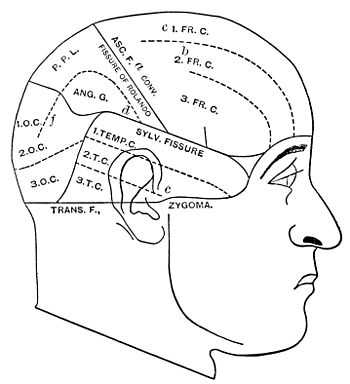muscles to contract under pleasurable emotions is shown by a curious fact communicated to me by Dr. Browne with respect to patients suffering from general paralysis of the insane: 'In this malady there is almost invariably optimism—delusions as to wealth, rank, grandeur—insane joyousness, benevolence, and profusion, while its very earliest physical symptom is trembling at the corners of the mouth and at the outer corners of the eyes. This is a well-recognized fact.'"
We have, then, sufficient evidence that the effect produced by a galvanic current on the portion of brain marked 7 in Ferrier's

Fig. 2.—Diagram of Cranio-Cerebral Relations. (Reid.)
| Some of the results of observations made by the early phrenologists: | Some of the results of experiments made by modern physiologists: |
| a, Hope: the organ of cheerfulness. | a, Center for the movements of the elevator muscles |(elevating the cheeks and angles of the mouth). |
| b, Imitation: the organ of mimicry. | b, Facial Nerve Center: center for facial movements. |
| c, Alimentiveness: the gustatory organ. | c, Gustatory Center. |
| d, Cautiousness: the organ of circumspection, fear, timidity. | d, Center for movements of the platysma myoides, the |muscle of fright. |
| e, Veneration: the organ of submission, respect, devotion. | e, Center for movements of the arm and raising of the |shoulders. Patience Muscles. |
| f, Attachment: the organ of friendship. |
topography is the physical expression of joy. We know, then, for positive that pleasurable emotions excite this center. But I do not say that it is the function of the center to produce an emotion of joy—a manner after which the old phrenologists would have expressed themselves—I merely note that all pleasurable emotions produce a nerve-current, which takes its start in this region.
